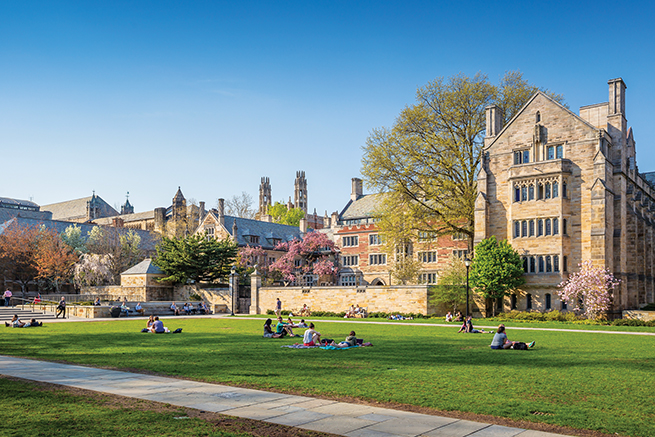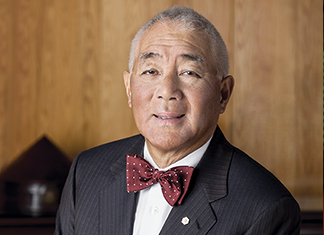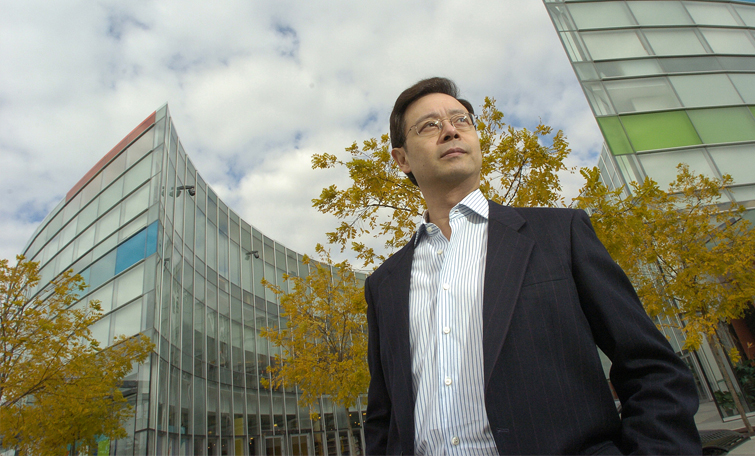North America Higher Education Overview
- Caifu Magazine | by Catherine Skrzypinski
- EN
While students flock to ivy-covered buildings on college campuses across North America to attend classes in ornate lecture halls and pull all-nighters studying in their dorms, higher education leaders and experts say the postsecondary education landscape is changing in the 21st century.

While students flock to ivy-covered buildings on college campuses across North America to attend classes in ornate lecture halls and pull all-nighters studying in their dorms, higher education leaders and experts say the postsecondary education landscape is changing in the 21st century.
The traditional college experience – what a campus looks like, how professors deliver class lectures, and what kinds of students colleges and universities serve – is transforming right in front of our eyes.While students flock to ivy-covered buildings on college campuses across North America to attend classes in ornate lecture halls and pull all-nighters studying in their dorms, higher education leaders and experts say the postsecondary education landscape is changing in the 21st century.
“Students still will to cross any barrier to get a North American degree,” noted Karen Southall Watts, a speaker and consultant who counsels entrepreneurs and small businesses on communications and social media strategies in both the United States and Canada.
Students from all over the world – including China – have set their sights on attending college or university in North America. Total undergraduate enrollment in degree-granting postsecondary institutions in the United States was around 17.5 million students in fall 2013, an increase of 46 percent from 1990 when it was 12 million students, according to the U.S. Department of Education’s National Center for Education Statistics (NCES). By 2024, statistics project total undergraduate enrollment in American institutions will increase to 19.6 million students.
As of fall 2013, female students on U.S. campuses make up 56 percent of total undergraduate enrollment at 9.8 million, the NCES reported. Male students made up 44 percent at 7.7 million.
Universities have also experienced tremendous growth in Canada in the past 30 years. Around 1.2 million students are enrolled in degree programs on Canadian campuses as of 2010 – 755,000 undergraduates, 143,000 graduates studying full time, and an additional 275,800 students studying part time, according to the Association of Universities and Colleges of Canada (AUCC). The number of full-time university students has more than doubled since 1980 – back then, approximately 550,000 full-time students earned an education at Canadian colleges and universities.
Fifty-six percent of university students in Canada are women as of 2010, while 10 percent are international students, the AUCC stated.
“Higher ed is now open to the masses,” said Tyce Henry, associate director at The Boston Consulting Group in Washington, D.C. “A [undergraduate degree] is much more than a degree; it shows employable skills.”
Great Recession’s Impact on Higher Education
Even though enrollment at North American institutions of higher learning is at an all-time high, leaders in the higher education sphere attribute that to a growing population poised to correct itself. A National Center for Education Statistics 2012 report has predicted the population of college-age students in the United States will decline for the first time in three decades.
Higher education experts debate whether the demand for higher education in North America has peaked. Since the global economic downturn in 2008, North American postsecondary institutions have faced financial challenges, such as budget cuts in many states, along with tuition increases across the board.
“Younger students are questioning whether college is a good investment. Is college worth it?” questioned Joni Finney, Ph.D. and professor of practice at the University of Pennsylvania in Philadelphia. She is also the director of the Institute for Research on Higher Education. “This may hurt [the United States] as that threatens leadership, and can thwart talent and innovation,” Finney said in an interview with Caifu Magazine on Friday, July 24.
In the years following the Great Recession, the U.S. Census Bureau reported in 2012 that individual state governments not only suffered deep declines in tax revenues, but also faced steep cuts in state aid. State governments once funneled enough money into public universities, but state budgets across the United States have been slashed annually since 2009.
“How to fund postsecondary education since the Great Recession is shaping opportunities in higher education in the future,” Finney noted. “The deep [budget] cuts in states will impact the next generation.”
If state education expenditures continue their long-term decline, then public universities that remain heavily dependent on state funding will find themselves increasingly unable to cover their costs, Henry added.
Since the start of the Great Recession, American students and their parents are paying more of the cost of attending public universities than state governments, a shift that is making college less affordable in the United States, according to a December 2014 U.S. Government Accountability Office report.
Robert R. Johnson, Ph.D., and president and CEO of The American College of Financial Services in Bryn Mawr, Pennsylvania, responded to the higher education trends since the Great Recession, paraphrasing late 19th century American author Mark Twain: “The reports of higher education’s death are greatly exaggerated.”
Moody’s Investors Service upgraded its outlook in July 2015 for the higher education sector from negative to stable. Moody’s had assigned a negative outlook to the higher education sector in early 2013. Moody’s analysts report they believe over the next 12 to 18 months, revenue growth at colleges and universities will be slightly above 3 percent.
“This, however, does not mean that the entire industry should exhale,” Johnson told Caifu Magazine on Tuesday, July 21. “As a whole, medium and large state and private institutions are in the best fiscal shape. On the other hand, regional public universities and small private colleges are still suffering from financial strain.”
Tuition costs at American institutions have risen around three times faster than inflation in 2014, according to the College Board. The average cost of tuition and fees for the 2014–2015 school year in the United States was $31,231 at private colleges, $9,139 for state residents at public colleges, and $22,958 for out-of-state residents attending public universities, stated a November 2014 report by the College Board.
Meanwhile in Canada, the average cost of a year’s tuition at a Canadian university in 2014-2015 was $5,959, a 3.3 percent increase from the previous academic year, according to Statistics Canada. Tuition fees rose in all but one province, Newfoundland and Labrador, where tuition fees for undergraduate and graduate students have been frozen since the 2003-2004 academic year.
“Tuition costs go up, no matter whether the economy is good or bad,” Finney said. “Higher ed needs to learn to live within its means. …But the question remains: Who are we [in the United States] trying to educate – affluent or low-income students?”
Johnson countered that it is ironic that industry insiders are currently questioning the monetary value of a college education. “Higher education is worth the cost and it isn’t even close,” Johnson explained. “The bottom line of studies that measure the monetary value of a college degree tends to be the same – that the lifetime earnings of individuals with college degrees is substantially higher than those without college degrees.”
According to a Pew Research Center March 2012 study, the average U.S. college graduate earns more than $650,000 over a 40-year career, compared to someone with a high school education.
The pay gap between college-educated students and those without is widening, not narrowing, Johnson continued. Americans with a four-year college degree made 98 percent more an hour on average than people without a degree in 2013, according to U.S. Department of Labour statistics by the Economic Policy Institute in Washington, D.C.
Higher education often errs in not touting the benefits of merely being a more educated person, Johnson elaborated. “Higher education excels in simply expanding an individual’s mind and opening new worlds through the education process.”
The Millennials’ Struggle to Find Jobs
When students graduate college and enter the working world in North America, nearly half of recent graduates say it takes a long time to find their first full-time job in their field of study. Millennials are having a hard time getting into the workforce, Henry stated. “Entry-level jobs are hard to come by [in the United States] since the Great Recession because of pent-up supply.”
The millennial generation is still lagging in the workplace, as they make up about 40 percent of the unemployed in the U.S. in 2014, said Anthony Carnevale, a director and research professor for Georgetown University’s Center on Education and the Workforce.
In Canada, youth unemployment – workers aged between 15 and 24 – is around 13.6 percent as of April 2015, according to Statistics Canada.
On the other hand, many North American-based companies and employers say current college graduates are not particularly well prepared to achieve the learning outcomes they view as important in the workplace, according to a January 2015 report by the Association of American College and Universities.
To bridge the gap, Don Mroz, Ph.D., president of Post University and founding dean of the Malcolm Baldrige School of Business in Waterbury, Connecticut, told Caifu Magazine on Friday, July 24 that college and university professors should focus on developing students’ soft skills in addition to their hard skills. “Soft skills can be more difficult to teach,” he added. “As companies face increased pressure to be innovative to remain viable, many business leaders are recognizing soft skills – creativity through brainstorming, collaboration in team projects, communication, and critical thinking – in order to product graduates who are well-prepared for the workforce.”
Soft skills are critical components for a successful career – from the first interview through retirement, Mroz explained. “It is important for higher education to take the lead in developing their students’ soft skills by emphasizing their importance in all courses. The traditional problems often taught in many business schools are not always mirrored by what graduates encounter in the workplace.”
Henry of the Boston Consulting Group added that some universities might beef up their vocational offerings, such as engineering and nursing, to ensure students have the skills to succeed in the workplace.
Students should also be realistic in determining their field of study, Johnson advised. “I am a big believer in having young men and women follow their passions. Someone once told me 'find something you love to do. If you love to do it, you will do it often and get good at it. If you get good at it, someone will pay you for it.’”
“While that is true to an extent, some research on career prospects would likely increase the return on investment [ROI] of an individual’s education,” he continued. “The horror stories we hear about with individuals with huge student loan balances working as waiters and waitresses are highly concentrated in disciplines with poor economic prospects. Not all college degrees are created equally.”
Predictions for the Future of Higher Education
While the methods of education at North America colleges and universities are evolving, including online education and accelerated learning, changes in higher education policies are slower to implement, Henry stated.
“I don’t think higher education is going anywhere,” Chester Goad, Ed.D, and director of disability services at Tennessee Tech University in Cookeville, Tennessee, wrote in an email. “Instead we’ll see increased focus on technological advances, improving accessibility to higher education across underrepresented populations, including individuals with disabilities, as well as prospective students from lower socioeconomic backgrounds.”
Johnson mentioned colleges and universities will continue to tap into their industry connections to offer internships to students so that they get the relevant work experience that makes them more employable upon graduation.
Southall Watts said she believes there will be a greater emphasis on apprenticeship, practical application and hands-on learning – successful vocational methods applied in Germany and Switzerland – in the coming years. “We need technicians who have worked with real materials, programmers who’ve done lots of coding and teachers who’ve been in a supervised class for more than the minimum number of hours,” she added.
Goad added that an entrepreneurial trend is occurring in the United States, with many potential students opting to bypass higher education in pursuit of online business or niche marketing. “Opportunities exist for educational systems to tailor programs that appeal to the entrepreneurial spirit,” he said.
“Many of the leading academic institutions in the world are in the United States and Canada – the most on a per capita basis,” Johnson concluded. “For all of the purported problems with the educational systems in the U.S. and Canada, much of the world still sends their best and brightest to be educated in the U.S. and Canada. The future of higher education in the U.S. and Canada is very bright.”















